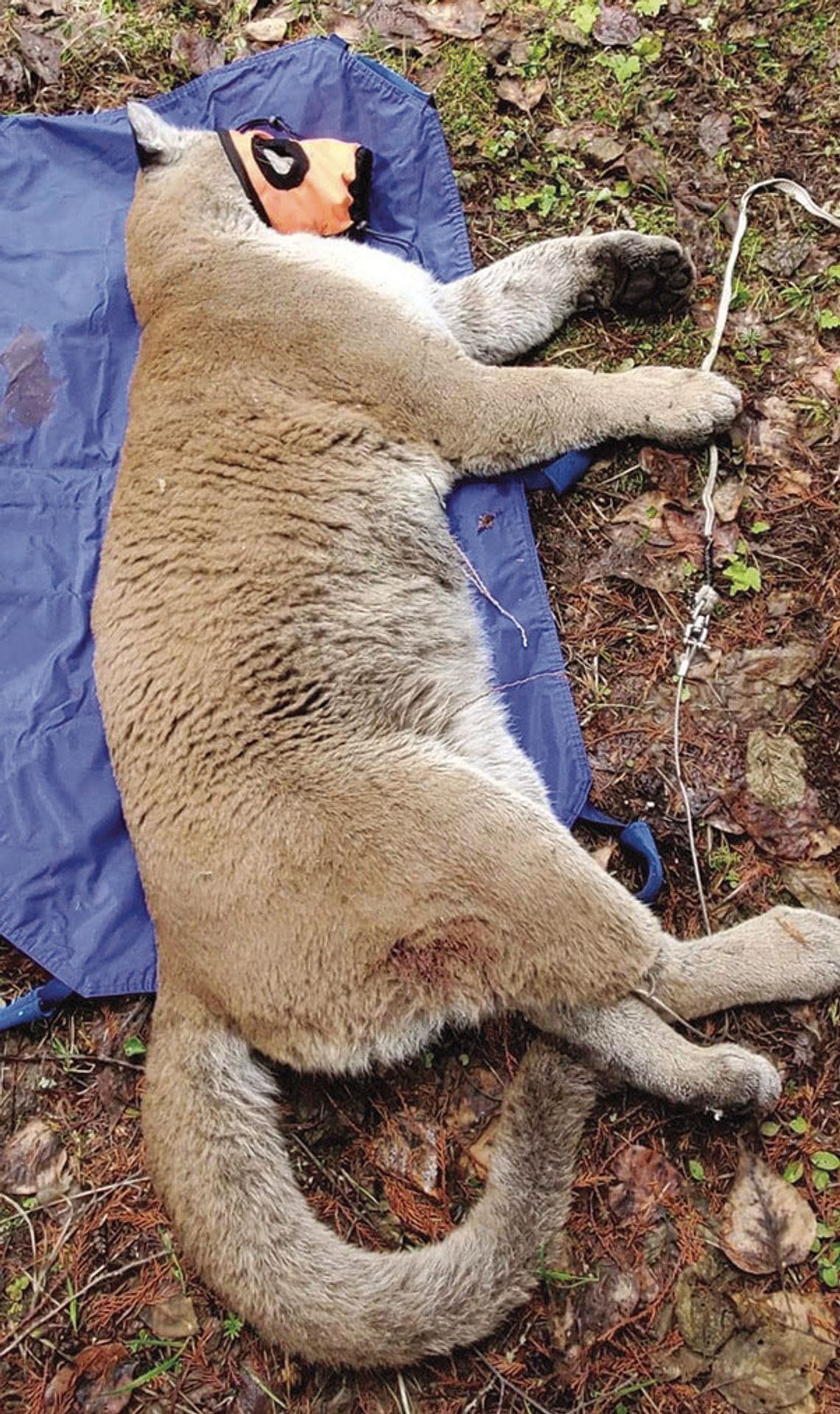Study shows cats move away from hounds, not people
NEWPORT – Bart George, a biologist with the Kalispel Tribe, says getting close to mountain lions, also known as cougars, can be intimidating.
George has experience getting close to the big cats. He was part of a four-year study published in November that involved approaching GPS-collared cougars with a loudspeaker. He sometimes got as close as 10 meters, less than 30 feet.
“It’s a little unnerving getting that close,” he says. “A lot of times you know where they are but don’t see them. It’s a little unnerving when they’re looking at you, but you don’t see them.”
Lance Gibson also knows about having a cougar too close. Five or six years ago, at about 10 a.m. he was changing the battery in a vehicle at his property about a mile up the mountain from Ione. There was a compressor running and he was listening to an audio book when he saw chickens run through the garden. He turned around and saw a cougar.
“I thought he’ll see me and run off,” he says. But the cat didn’t. Instead, it got into a low crawl and started moving towards him.
“Thank God I had a gun on me,” he says. When the cat got about 12-feet away from him, the retired detective shot the animal in the chest. The animal jumped in the air and Gibson shot what he estimates was a about a 200-pound cat several more times. The cougar ran off. Gibson said he wished he had a rifle with him. His .40 caliber handgun never looked so small.
“It felt like it was a .22,” he says.
Conflicts a problem
Conflicts between cougars and humans, their livestock and pets, have been a problem in Pend Oreille County for years.
The second week of January a cougar killed a pet on the east side of the Pend Oreille River, off Sandwich Road, the Washington Department of Fish and Wildlife reported in their website that tracks cougar, wolf and grizzly bear sightings and interactions with people and their animals.
The cougar was tracked and killed by WDFW, “lethally removed.” In November, two other cats were killed, one after it killed livestock and another after a person reported a safety risk with a cougar.
Pend Oreille County commissioner Brian Smiley, of Metaline, had two of his family’s goats and a pig killed by cougars in separate incidents by different cougars. The goats were killed within 100-feet of Smiley’s house. Those two cats were also lethally removed by WDFW-contracted hunters.
Smiley has lived in the county all his life.
“It is clear to me that there has been a steady increase in not just the population of cougars but also in their interactions and conflicts with humans over the last 20 years,” he says.
Smiley blames the increase on a 1996 citizens’ initiative that banned hunting the big cats with hounds. He says recent studies have shown that hunting with hounds is effective from a population control perspective but also changes the behavior of the big cats. Other methods of hunting are just not effective.
Washington doesn’t allow recreational
cougar hunting with hounds
While Washington does allow recreational hunting of cougars without hounds, George, the biologist, says almost all the cougars that are killed during the cougar hunting season are shot by hunters who happen upon them while hunting other species like deer and elk.
Idaho does allow recreational cougar hunting with hounds.
One of the goals of George’s study was to see if such interactions between cougars that have become increasingly used to humans, habituated, as researchers say, could be reduced.
“Human-wildlife conflict creates negative outcomes for both people and wildlife by threatening human safety and property and leading to the persecution of wildlife,” according to the study. “Conflict with large carnivores results in real threats to human interests and safety …” The study involved approaching about 50 GPS collared cougars in Pend Oreille, Stevens and Spokane counties. The big cats were first approached by researchers with loudspeakers broadcasting a podcast at 80 decibels, about the level of a conversation among several people. Then 39 were chased, or hazed, with hounds. A dozen were not hazed and served as the control group with which to compare the cats that were hazed. The idea was to see if cougars could be conditioned to stay away from humans. Those that were chased with dogs moved farther away more quickly than those that were not chased.
“In contrast, the control group displayed a habituation response, allowing humans to approach closer during subsequent trials,” the study reported.
The study, “Evaluating the Efficacy of Aversive Conditioning of Mountain Lions with Hounds,” was published in a journal of the Canadian Wildlife Biology & Management.
The study recommends further critical study of using hounds to “haze” mountain lions to see if it keeps cougars away from people.
Cougars sometimes attack and kill people
In addition to killing livestock and pets, cougars have attacked and occasionally killed people.
A 2024 attack described in a Jan. 5 New York Times Magazine story told of two brothers in northern California that were attacked by a 90-pound cat, killing one brother and severely injuring the other. In 2022, a 9-year-old girl in Stevens County was attacked by a cougar while playing hide and seek at a camp near Fruitland. She survived. In 1998, a 5-year-old child was attacked near a campground in Metaline Falls.
Attacks on people and especially fatalities are rare. Washington Department of Fish and Wildlife reports that in Washington cougars have killed two people and injured at least 20 in the last 100 years.
WDFW Police Officer Severin Erickson says other animals such as black bear and moose have more reported human attacks than cougars. The difference is that when a black bear attacks, it is usually defensive. When a cougar attacks, it is predatory.
He said in the 16 years he’s worked for WDFW, there are variations in cougar problems. He says that weather often plays a role. Hard winters drive the cougar’s prey down from the mountains. Dry summers drive the prey towards water. Both mean the big cats are more likely to encounter people or their animals.
Feeding wildlife such as deer also attracts cougars.
“Feeding wildlife in populated areas is a bad idea,” Erickson says.
People always have a right to defend themselves against cougars, he says. They should always report cougar interactions, especially if they shoot one in self-defense.
People should take precautions
Even though cougar attacks on people are not common, people who live in cougar country should be aware of the possibility and take precautions George says he carries bear spray with him when in the woods, something he recommends. He says people can reduce the chance of mountain lion attacks on their livestock and pets by doing things such as keeping brush cut near homes and where animals are housed. Using a sturdy electric fence is also a good form of animal husbandry that can protect livestock, he says.
Smiley says he teaches his kids that there is no reason for people to be in fear, but at the same time, they need to be aware of the possibility of a cougar encounter. Still, he says he doesn’t want cougars or other predators eliminated.
“I love the fact that we live in a place where we still have predators,” he says, “For my part I hope they never go away, but I think we need to improve upon achieving a balanced perspective on what is an appropriate management and conservation of those predators.”
.png)







